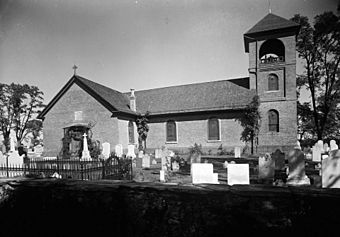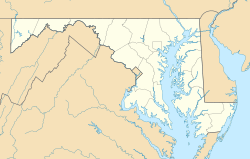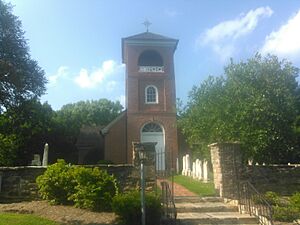St. James Church (Monkton, Maryland) facts for kids
Quick facts for kids |
|
|
St. James Church
|
|
 |
|
| Location | 3100 Monkton Road, Monkton, Maryland |
|---|---|
| Area | less than one acre |
| Built | 1755 |
| Architectural style | Georgian |
| NRHP reference No. | 74000941 |
| Added to NRHP | September 12, 1974 |
St. James Church is a very old Episcopal church located in Monkton, Maryland, in Baltimore County, Maryland, USA. It is a special historic building.
Contents
The Story of St. James Church
Early Days and My Lady's Manor
In 1713, a powerful leader named Charles Calvert, 3rd Baron Baltimore gave a large piece of land, about 10,000 acres, to his wife. This land later became known as My Lady's Manor. People started settling in this area more in the 1700s. A grist mill, which grinds grain, was built along the Gunpowder River in Monkton.
A small church, called a chapel of ease, was built for the people living there. Priests from a church in Joppa would visit regularly to hold services.
Becoming Its Own Parish
In 1770, Maryland's government decided that St. James should be its own separate church area, called a parish. Before this, it was part of St. John's Parish. A few years later, in 1773, Baltimore and Harford Counties were split apart. The Gunpowder River became the border between them.
During the American Revolutionary War, the land of My Lady's Manor was taken by the new state of Maryland. The church building itself was used to store gunpowder. After the war, in 1782, Maryland sold the nearby lands to farmers. Many families who bought land then still live in the area today. By 1795, the church had about 1600 members.
Roads and Railways
Monkton Road was an important path for Native Americans and later during the Revolutionary War. However, a new road built in 1803 between Baltimore and York, Pennsylvania changed things. This new road, and people moving west, meant that the Monkton area stayed mostly rural.
Still, the nearby town of Monkton became a stop on the Baltimore and Susquehanna Railroad. This railway later became part of the Pennsylvania Railroad. Eventually, the train line was closed. Today, it is a popular path for biking and walking called the Northern Central Railroad Trail.
What the Church Looks Like
Building Design and Changes
The main church building was finished in 1755. It was built with bricks and measured about 60 by 30 feet. Its style is called Georgian, which was popular at the time. Over the years, more parts were added to the church in the 1700s, 1800s, and 1900s.
The inside of the church was last updated in 2005. This included changes to the box pews, which are like enclosed seating areas. The tall bell tower was added in 1884. A cemetery, where people are buried, surrounds the church and is enclosed by a stone wall.
Other Buildings and Recognition
A school was built next to the church in 1821. However, its buildings were taken apart in 1884. The bricks from the old school were used to build the new bell tower. A parish hall, which is a community building, was built in 1904 and made bigger in 1950.
The St. James Academy school was started again in 1957. It had a big update between 1994 and 1999. The school property is large, about 89 acres. It includes playing fields and a parking lot.
Because of its history and special architecture, St. James Church was added to the National Register of Historic Places in 1974. This list includes important historic places across the United States.
Notable Burials
- Charles B. Bosley (died 1959), a lawyer and state delegate from Maryland.
See also
- List of post 1692 Anglican parishes in the Province of Maryland




